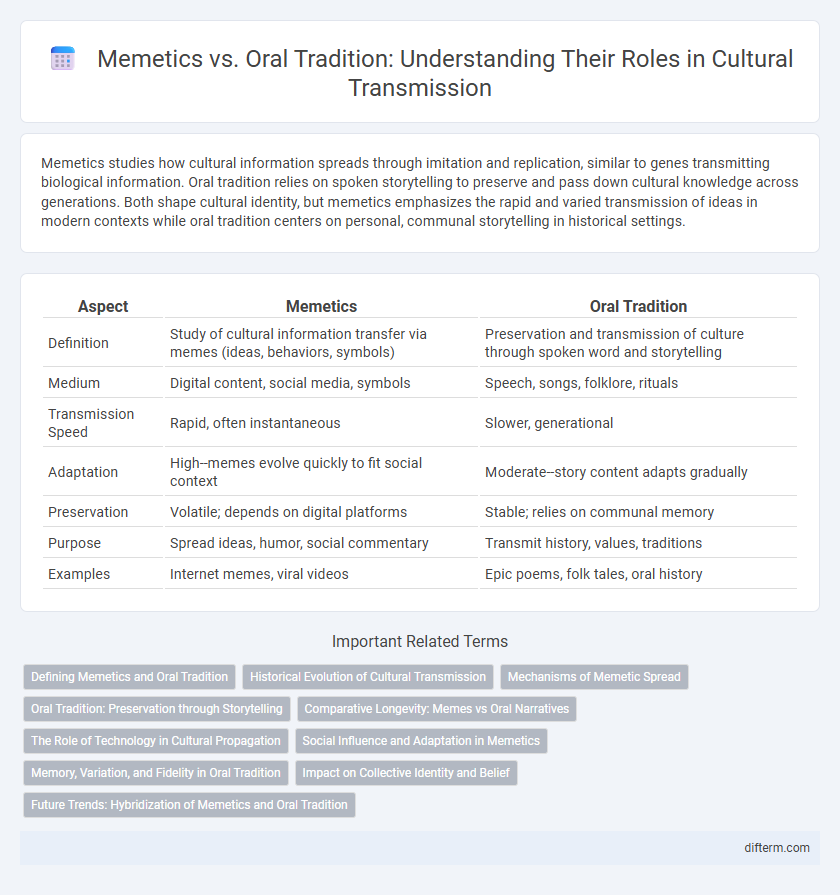Memetics studies how cultural information spreads through imitation and replication, similar to genes transmitting biological information. Oral tradition relies on spoken storytelling to preserve and pass down cultural knowledge across generations. Both shape cultural identity, but memetics emphasizes the rapid and varied transmission of ideas in modern contexts while oral tradition centers on personal, communal storytelling in historical settings.
Table of Comparison
| Aspect | Memetics | Oral Tradition |
|---|---|---|
| Definition | Study of cultural information transfer via memes (ideas, behaviors, symbols) | Preservation and transmission of culture through spoken word and storytelling |
| Medium | Digital content, social media, symbols | Speech, songs, folklore, rituals |
| Transmission Speed | Rapid, often instantaneous | Slower, generational |
| Adaptation | High--memes evolve quickly to fit social context | Moderate--story content adapts gradually |
| Preservation | Volatile; depends on digital platforms | Stable; relies on communal memory |
| Purpose | Spread ideas, humor, social commentary | Transmit history, values, traditions |
| Examples | Internet memes, viral videos | Epic poems, folk tales, oral history |
Defining Memetics and Oral Tradition
Memetics studies cultural transmission through units called memes, which replicate, mutate, and evolve similarly to genes, emphasizing how ideas spread and persist within societies. Oral tradition refers to the practice of passing cultural knowledge, stories, and customs verbally across generations, preserving heritage without written records. While memetics analyzes the patterns and mechanisms of idea propagation in cultures, oral tradition centers on the human practice of storytelling and verbal communication as vehicles for cultural continuity.
Historical Evolution of Cultural Transmission
Memetics analyzes cultural transmission through replicating units called memes, evolving similarly to genes by variation, selection, and retention. Oral tradition represents a foundational historical method where cultural knowledge and stories are passed down verbally across generations, emphasizing direct human interaction and memory. The historical evolution of cultural transmission reflects a shift from rote oral replication to digital and memetic propagation, enhancing speed and reach but also altering fidelity and interpretive dynamics.
Mechanisms of Memetic Spread
Memetic spread operates through digital replication, viral sharing, and algorithm-driven visibility, enabling rapid transmission across global platforms. Unlike oral tradition, which relies on face-to-face storytelling and communal memory, memetics leverages social media, memes, and internet culture to propagate ideas swiftly and widely. This digital mechanism fosters accelerated cultural evolution by facilitating diverse adaptations and reinterpretations in real time.
Oral Tradition: Preservation through Storytelling
Oral tradition serves as a vital cultural conduit, preserving historical narratives and ancestral wisdom through generations via storytelling. This method maintains cultural identity by embedding values, beliefs, and social norms within memorable tales and rituals. As a dynamic transmission form, oral tradition adapts stories to contemporary contexts while safeguarding authentic heritage from distortion.
Comparative Longevity: Memes vs Oral Narratives
Memetics, as units of cultural transmission, often spread rapidly through digital networks but face risks of distortion and obsolescence over time. Oral traditions, rooted in repeated storytelling across generations, demonstrate remarkable longevity by preserving cultural knowledge and collective memory within communities. Comparative studies show oral narratives maintain consistency and cultural depth longer than fleeting digital memes, highlighting their enduring role in sustaining cultural identity.
The Role of Technology in Cultural Propagation
Technology accelerates the spread of memetics by enabling rapid digital replication and mutation of cultural units through social media platforms and online communities. Oral tradition relies on face-to-face interaction and memory, limiting the speed and geographic reach of cultural transmission but preserving narrative depth and communal experience. Digital tools transform cultural propagation by blending memetic efficiency with traditional storytelling elements, reshaping how cultural knowledge is created, shared, and sustained.
Social Influence and Adaptation in Memetics
Memetics analyzes cultural transmission through discrete units called memes that evolve by replication and variation, enabling rapid social influence and adaptation across diverse communities. Oral tradition relies on human memory and storytelling, subject to gradual modifications but constrained by the limitations of individual recall and performance contexts. Memetics enhances the understanding of cultural dynamics by modeling how ideas propagate, transform, and stabilize within social networks, driving collective adaptation more fluidly than traditional oral methods.
Memory, Variation, and Fidelity in Oral Tradition
Oral tradition relies on collective memory to transmit cultural knowledge across generations, emphasizing fidelity through repeated storytelling that minimizes variation. Memetics frames cultural transmission as a process akin to genetic evolution, where memes--units of cultural information--undergo variation and selection, often leading to diversified narratives. The interplay between memory accuracy in oral tradition and meme variation illustrates the dynamic balance between preserving cultural fidelity and fostering innovation within cultural evolution.
Impact on Collective Identity and Belief
Memetics shapes collective identity by rapidly transmitting cultural units (memes) through digital networks, fostering dynamic belief systems and cultural practices that evolve with high replication fidelity. Oral tradition preserves identity by embedding historical narratives and moral values in communal storytelling, reinforcing cohesion and continuity across generations through personalized, context-rich performances. Both mechanisms influence collective belief, with memetics promoting fast, adaptive cultural evolution and oral tradition sustaining deep-rooted cultural memory and social norms.
Future Trends: Hybridization of Memetics and Oral Tradition
Future cultural transmission trends indicate a hybridization of memetics and oral tradition, blending rapid digital meme propagation with the depth of storytelling passed through generations. This fusion enhances cultural evolution by integrating visual, textual, and performative elements within a digitally interconnected society. The resulting hybrid forms amplify engagement and preserve collective identity amidst accelerating technological change.
Memetics vs Oral tradition Infographic

 difterm.com
difterm.com